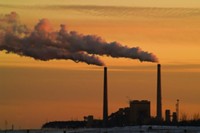Advertisement
Grab your lab coat. Let's get started
Welcome!
Welcome!
Create an account below to get 6 C&EN articles per month, receive newsletters and more - all free.
It seems this is your first time logging in online. Please enter the following information to continue.
As an ACS member you automatically get access to this site. All we need is few more details to create your reading experience.
Not you? Sign in with a different account.
Not you? Sign in with a different account.
ERROR 1
ERROR 1
ERROR 2
ERROR 2
ERROR 2
ERROR 2
ERROR 2
Password and Confirm password must match.
If you have an ACS member number, please enter it here so we can link this account to your membership. (optional)
ERROR 2
ACS values your privacy. By submitting your information, you are gaining access to C&EN and subscribing to our weekly newsletter. We use the information you provide to make your reading experience better, and we will never sell your data to third party members.
Environment
Paring Power Plant Pollution
Emissions: EPA proposal targets smog, particulate matter, and acid rain
by Cheryl Hogue
July 7, 2010
A new proposal from EPA would reduce power plant emissions that blow across state lines and cause smog, particulate pollution, and acid rain.
The July 6 proposal would affect coal-, oil-, and natural gas-fired power plants in 31 Eastern states plus the District of Columbia. It would protect public health and help states meet federal clean air standards, says Regina A. McCarthy, EPA assistant administrator for air and radiation. Some states struggle to comply with those standards because of pollution drifting in from other jurisdictions.
"We’re working to limit pollution at its source, rather than waiting for it to move across the country," says EPA Administrator Lisa P. Jackson.
Under the proposal, power plants would have to curb their emissions of sulfur dioxide, which causes acid rain and particulate pollution, and nitrogen oxides, which are precursors to ground-level ozone or smog. Particulates and ozone can trigger asthma, cause heart attacks and strokes, and lead to premature death.
When finalized, the proposal will replace the Bush Administration's 2005 Clean Air Interstate Rule, which cuts SO2 and NOx from power plants in 28 Eastern states and the District of Columbia. In 2008, a federal court determined the 2005 rule had several fatal legal flaws, and directed the agency to start from scratch on a new regulation to supplant it (C&EN, July 21, 2008, page 13). In the mean time, the court allowed the 2005 rule to continue as a stopgap measure (C&EN, Jan. 5, 2009, page 18).
The new proposal would make somewhat larger reductions in pollution than the 2005 rule. According to McCarthy, the proposal would curb 6.3 million tons of SO2 emissions annually by 2012, which is 1 million more ton per year than the current, stopgap rule. The proposal would also cut 1.4 million tons of NOx each year by 2014, 100,000 tons more than the temporary measure, she says.
In addition, the proposal would set up a system for EPA to impose further cuts in power plant emissions that contribute to air pollution problems in downwind states. Analysis by EPA predicts that additional cuts in NOx emissions will be needed after 2014 for some states to meet federal air quality standards for ozone, McCarthy says.
It remains unclear whether power plants will be able to achieve the emission standards in the rule while providing affordable and reliable electric power, says Jeffrey R. Holmstead, a utility industry lawyer and partner in the Washington office of the law firm Bracewell & Giuliani. Holmstead oversaw development of the 2005 rule while he was EPA assistant administrator for air and radiation from 2001 to 2005.
EPA will accept public comment on the proposal for 60 days. The agency will then finalize the new rule in light of those comments.



Join the conversation
Contact the reporter
Submit a Letter to the Editor for publication
Engage with us on Twitter